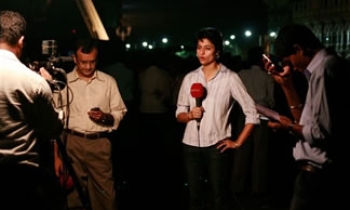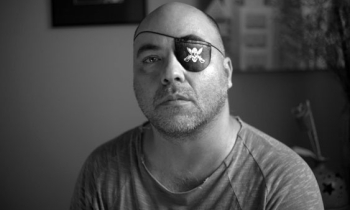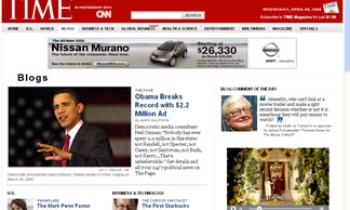My folks grew up in a town whose fortunes rose and fell on coal mining. When I lived in that town, I thought the men had the most exotic-looking eyes. Try as they would in post-work scrub-downs, the miners couldn't remove all the coal dust from their lids and it looked like permanent eyeliner to my 12-year-old mind.
I thought of those vivid, black-rimmed eyes this past week, watching and reading the coverage of the Sago mine explosion in West Virginia.
Those eyes -- and what they witness and endure as miners -- ought to be the focus of what unfolded at Sago, I think. But, depressingly, I find myself having to write about media coverage of the tragedy because, unfortunately, that became the news, too.
The Courier-Journal, like more than 100 other U.S. newspapers, was up against deadlines and dramatic plot twists when it went to bed last Tuesday night/Wednesday morning, printing a front-page story in its final edition that carried this hopeful headline: " 'Miracles happen;' 12 miners survive."
And like untold numbers of the same papers, The Courier printed an editor's note in Thursday's editions that endeavored to explain how the wrong story appeared in the final edition of Wednesday's paper. I'll repeat that editor's note here, because some of you may have missed it (and you did, if my e-mail is any indication):
"Sometimes, despite our best efforts, inaccurate stories get into The Courier-Journal. Yesterday's front-page story about the remaining 12 trapped miners in Tallmansville, W.Va., was an example. Here's how it happened.
"The Associated Press moved a bulletin at 11:52 p.m. Tuesday reporting that family members said 12 miners had survived. By 12:25 a.m., AP updated its story with Gov. Joe Manchin confirming that 12 miners had survived. Photos of jubilant family members were received.
"The story was the same at 1:30 a.m. when the newspaper began its final press run. And when an editor performed a final check at 2 a.m., there was no evidence the story was incorrect. It was almost one hour later, at 2:57 a.m., that AP moved a one-sentence bulletin saying that 11 of the 12 miners thought to have survived had in fact died.
"We were among many newspapers that, due to press deadlines and inaccurate early reports, got it wrong."
Regrettably, but not wantonly, got it wrong.
News is fluid. Newspaper deadlines are only marginally flexible. Comes a time, every night, when the button has to be pushed and the paper has to roll with what you think is the latest, and most accurate, report.
That inflexibility is one of the limitations of print -- in this case, a painful limitation. Print's indelibility is one of its powers as a medium -- but in this case, that indelibility was also a painful reminder of its inflexibility.
The immediacy of television and potential constancy of the Internet better serve those media in instances such as the mine tragedy. (And the Associated Press stories to which The C-J's Internet home page links, would have had the correct story after 3 a.m.) But let's remember those media got it wrong, too, again and again and again, until a little before 3 a.m. They were just able to fix the major misinformation before their print brothers and sisters could.
The Courier's Jan. 4 Page A1 headlines reflect the updating that went on throughout the evening:
"Body of 1 miner found; 12 missing,'' read the Early Metro headline, which printed before midnight. Photos of deeply worried people were on that page. (Ironically, later press times worked against The Courier in this case.)
"Kin told trapped miners are alive," read the headline in the Indiana edition, which was shipped to the press from the newsroom at 12:15 a.m. Updated photos of joyful people replaced the earlier, grim photographs. (In retrospect, this was a better headline than the final edition headlines, which relied too much on facts believed to be true, but were not established.)
" 'Miracles happen;' 12 miners survive," was the headline on the final edition, the vast majority of which was printed before the tragic news was aired and confirmed.
The last of the night news crew stayed until 2 a.m. Wednesday morning to check the final edition as it rolled off the press. They're here to make any last-minute changes or fixes to big or obvious problems -- such as an Indiana edition page showing up in a Metro edition, or a misspelled headline.
The big bulk of work has and had been done by that point.
Tom Beshear, night news editor, describes his crew's daunting, gatekeeping work to ensure the latest, soundest news: "The night copy desk monitors the AP (Associated Press) and The New York Times, Gannett and Washington Post-Los Angeles Times news services. We keep a TV set on one of the cable news channels."
And this goes on all evening, every evening.
It's easy, in retrospect, to pick at weaknesses in stories filed on deadline, on the fly, in the middle of the night, and in the middle of a heart-wrenching human drama.
But the sad fact of this mining coverage is: Families were told their relatives were alive. The governor announced it. We reported it.
As Beshear said, "If the reporting had been ambiguous, we would have kept the late-stay editors longer. Unfortunately, it wasn't ambiguous. It was wrong. The governor of West Virginia was told something that was untrue by mine officials, and he told the news media, who told the world."
I asked Tom Rosenstiel, director of the Project for Excellence in Journalism, about what journalists and news consumers should take from the challenges and mistakes in this coverage.
A few of Rosenstiel's thoughts:
" . . . The most important thing is to level with the public about what you know, how you know it, and what you don't know. Don't pretend to know more than you do. Don't pretend to false omniscience.
"There is a big difference between: 'Family members heard word that the miners were safe and began cheering. There was no official confirmation of their rescue.' Versus: '12 miners were saved, family members said.'
"One is precise and accurate and given the passage of time, was a true snapshot in time.
"The other is vague and pretends, through vagueness, to a level of authority that isn't there."
" . . . The problem here is no one expects the information to be wrong. The expectation is they would never mislead the families. Who would ever imagine anyone would. We have to see this situation in context.
"That said, journalists who are carefully trained should always be worried about being wrong, worried about it like it is a kind of death, and until they have that formal confirmation, from someone on the scene, they shouldn't confuse that with hearing from someone who is an 'official,' the governor, but in this case the 'official word.'
"I know it sounds harsh, but this frankly is the heart of what we do. That starts with getting the facts right. Was this a horrible mistake? No. Under the circumstances, it is an understandable one, frankly, and one many might be prone to make. But it is a mistake."
A final thought from me:
The real story here, of course, isn't about the media but about the 13 miners and their dangerous trade and the toll it took on them and their families.
Once we get past the heat and light of their tragedy, where are the media? Where are the people? Where is the interest in the work and the working conditions of the people who make so much of our life and lifestyle possible?
I lived in a coal town for a little while, a long time ago, and I carry the memory of those coal-lined eyes with me to this day. But even I don't think about this often enough.
Pam Platt is the public editor of The Courier-Journal. Call her at (502) 582-4600; e-mail her at pplatt@courier-journal.com









